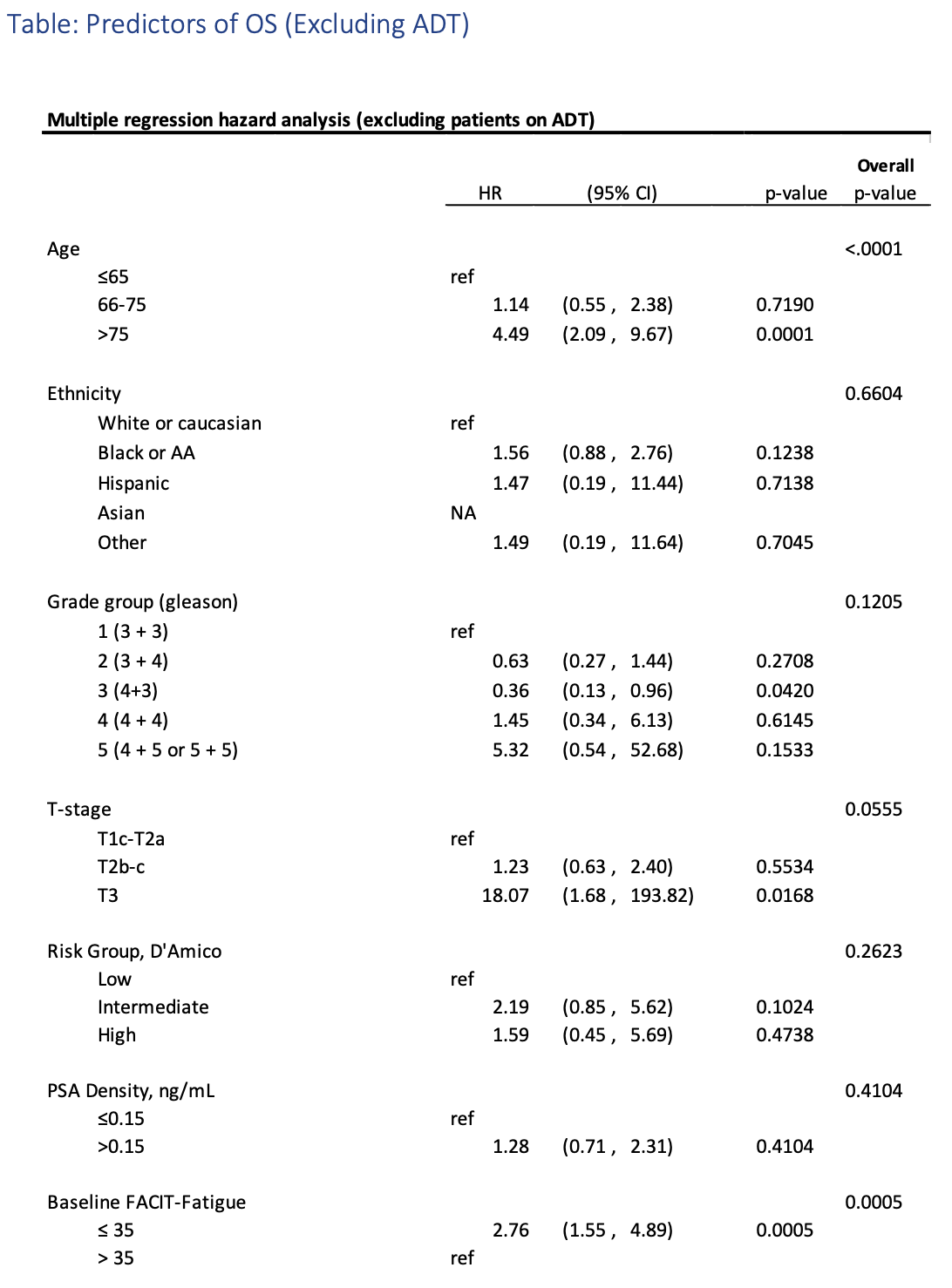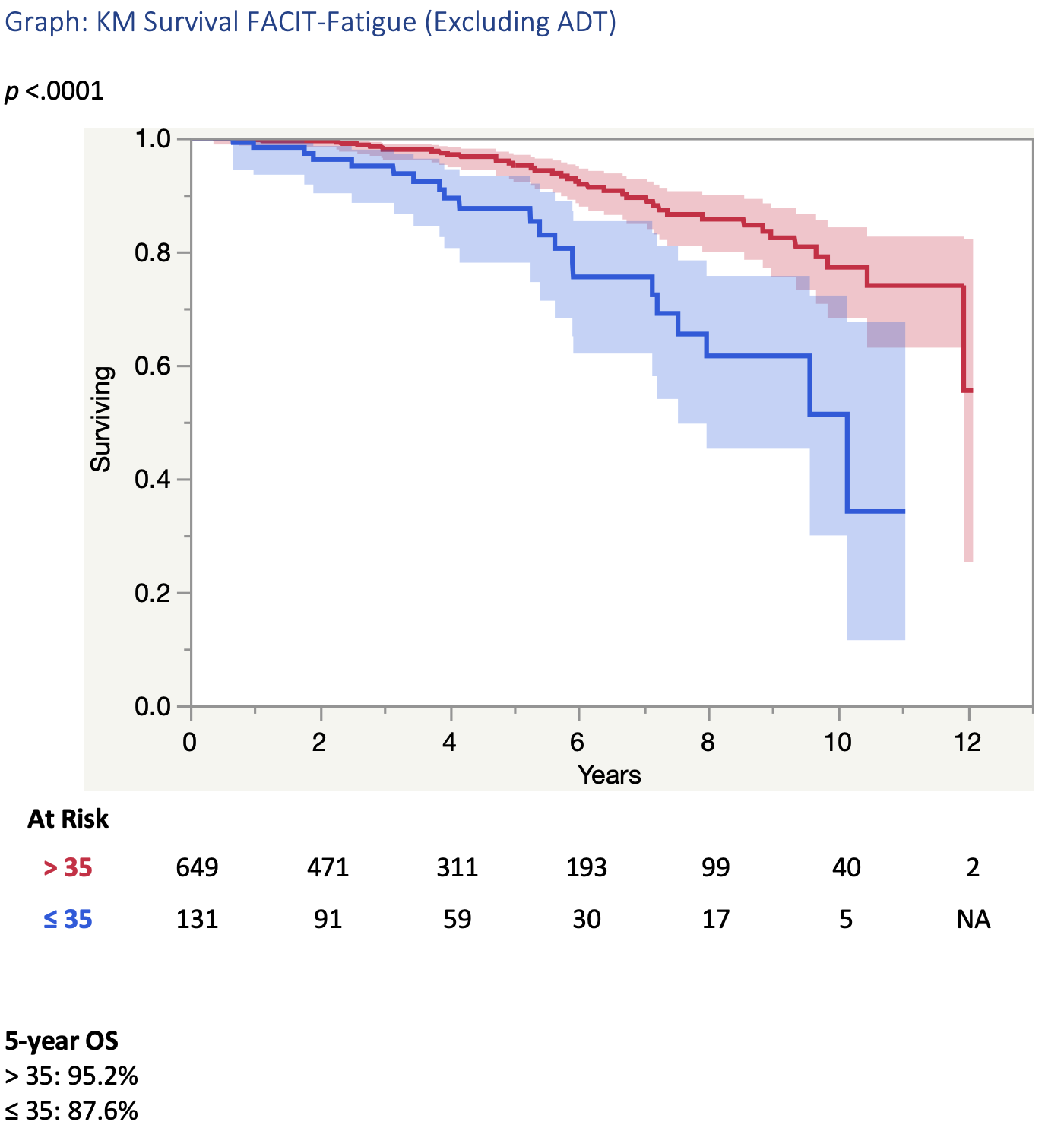Back
Poster, Podium & Video Sessions
Podium
PD22: Prostate Cancer: Localized: Radiation Therapy
PD22-07: Baseline Self-Reported Fatigue Predicts Overall Survival After Stereotactic Body Radiation Therapy for Localized Prostate Cancer
Saturday, May 14, 2022
10:30 AM – 10:40 AM
Location: Room 252
Rishabh Simhal*, Tamir Sholklapper, Washington, DC, Anish Simhal, New York City, NY, Alan Zwart, Malika Danner, Washington, DC, Deepak Kumar, Durham, NC, Nima Aghdam, Boston, MA, Simeng Suy, Ryan Hankins, Keith Kowalczyk, Sean Collins, Washington, DC
- RS
Podium Presenter(s)
Introduction: Stereotactic Body Radiation Therapy (SBRT) has emerged as a definitive therapy for localized prostate cancer (PCa). However, more data is needed to predict patient prognosis to help guide which patients will benefit most from treatment. The FACIT-Fatigue (FACIT-F) is a well-validated, widely used survey for assessing fatigue. However, the role of fatigue in predicting PCa survival has yet to be studied. Herein, we investigate the role of FACIT-F as a baseline predictor for overall survival (OS) in patients undergoing SBRT for localized PCa.
Methods: A retrospective review was conducted of 1358 patients who received SBRT monotherapy between January 2008 to April 2021 at an academic, tertiary referral center. FACIT-F scores (range 0 to 52) were summed for patients who answered all 13-items on the survey. FACIT-F total scores of =35 represented severe fatigue. Patients receiving androgen deprivation therapy were excluded. Differences in fatigue groups were evaluated using chi-squared tests. OS rates were determined using the Kaplan-Meier method and predictors of OS were evaluated using Cox proportional hazard method.
Results: Baseline full FACIT-F scores and survival data was available for 780 patients. 5-year OS was 87.6% and 95.2%, respectively, for the severely fatigued and non-fatigued groups. Chi-squared analysis of fatigue groups showed no significant difference in the following categories: D’Amico risk group, age, ethnicity, grade group, T-stage, or PSA density. Severe fatigue was associated with a significant decrease in OS (hazard ratio 2.76; 95%CI 1.55 - 4.89; p <.0001). The Cox proportional hazard model revealed that age and FACIT-F were both statistically significant (p <0.05).
Conclusions: Baseline FACIT-F scores are significantly associated with OS. Higher FACIT-F scores, representing less fatigued patients, are associated with an overall survival benefit. These results indicate that the FACIT-F survey could serve as an additional PCa prognostic metric.
Source of Funding: None


Methods: A retrospective review was conducted of 1358 patients who received SBRT monotherapy between January 2008 to April 2021 at an academic, tertiary referral center. FACIT-F scores (range 0 to 52) were summed for patients who answered all 13-items on the survey. FACIT-F total scores of =35 represented severe fatigue. Patients receiving androgen deprivation therapy were excluded. Differences in fatigue groups were evaluated using chi-squared tests. OS rates were determined using the Kaplan-Meier method and predictors of OS were evaluated using Cox proportional hazard method.
Results: Baseline full FACIT-F scores and survival data was available for 780 patients. 5-year OS was 87.6% and 95.2%, respectively, for the severely fatigued and non-fatigued groups. Chi-squared analysis of fatigue groups showed no significant difference in the following categories: D’Amico risk group, age, ethnicity, grade group, T-stage, or PSA density. Severe fatigue was associated with a significant decrease in OS (hazard ratio 2.76; 95%CI 1.55 - 4.89; p <.0001). The Cox proportional hazard model revealed that age and FACIT-F were both statistically significant (p <0.05).
Conclusions: Baseline FACIT-F scores are significantly associated with OS. Higher FACIT-F scores, representing less fatigued patients, are associated with an overall survival benefit. These results indicate that the FACIT-F survey could serve as an additional PCa prognostic metric.
Source of Funding: None



.jpg)
.jpg)